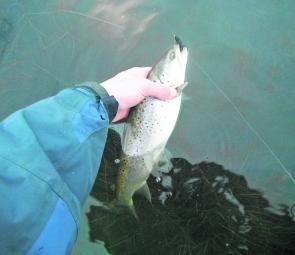The first half of the month is still very much winter-like in the highlands, but as we get into the last couple of weeks of the month there is a definite sense of spring in the air.
By this time many of the lakes and lagoons are starting to back up onto the ground that has been dry through late autumn and winter, aquatic and amphibious life is starting to move and the trout are getting very interested in spending more time in the shallows hunting down a feed.
Bronte and September seem to go together like strawberries and cream, the two words even seem to roll off the tongue well when spoken together and rightly so. There is just something special about being rugged up against the spring chill, standing just out of the shallows of Bronte Lagoon with a fly rod in hand and quietly waiting and looking for a subtle swirl or the tip of a tail to appear within casting range in the early morning or evening.
Good shores are the famous Long Shore, Fly Corner, Tailers Bay or Hut Bay but really any gentle sloping grassy shore or marshy corner will have fish patrolling looking for a feed. At times the fish can be in an aggressive mood and will rush at and eat a larger wet with gusto such as a MK2 Woolly Bugger, Sloane’s Fur Fly, Black Woolly Worm or the ever reliable Mrs Simpson and the smaller variant the Mrs Simmo. More often than not in September the fish are a bit cautious until the frogs really start to get active in October, so they are more likely to gently eat a Stick Caddis pattern, small Woolly Worm, Fiery Brown Beetle or a 007 nymph.
Out wide the lure casters are really hitting their straps, with the early months of the season being by far the better for trolling and casting.
This is a separate water to Bronte Lagoon but the same conditions apply. The fish here can be even more adventuress though, and it always amazes me when the water is backed up here on either side of the canal how often you’ll see a tail appear in water you’d swear isn’t deep enough to cover a trout, especially in the late afternoons. It really pays to fish with your eyes here and move very slowly; your casting must be up to scratch too, as some of the clear patches you have to cast to intercept a foraging fish are only coffee table size, often smaller when the water is way up.
Bradys, Binney and Tungatinah traditionally fish well through September and don’t forget about the 5,000 Great Lake adult browns that were released during winter. The areas around the White Water and the Dee tunnel at Bradys are hot spots as are the interconnecting canals that make this whole system the one water.
Many anglers cast soft plastics in and around the canals with a lot of success. The shallow tussocky corner of Tungatinah beside the Lyell Highway is a great spot and being sheltered in rough, northerly and westerly weather it can be a good fall back when the weather turns for the worst. When the water levels are right up there is some great flood water fishing here, especially when the rising water has washed corby grubs out of their homes. If nothing is showing, casting Woolly Buggers around the deeper water will produce. This time last year, this corner of Tungatinah saved the day for us, with four nice brownies being taken here on a terrible day on the reliable MK 2 Woolly Bugger .
Pine Tier is excellent for shore and boat angling. Last season some big bags were taken from the shallow northern basin by some Pine Tier regulars, mainly drift spinning and trolling. For the fly fisher the ideal shallows of the northern bay and its gutters are the main attraction. This is prime worming country, especially if the cattle have been grazing and have deposited the results of their grazing in the freshly flooded shallows: worm central!
Early and late in the day the fish will move in looking for their fill, again it pays to be patient, move too fast and you are likely to scare many unseen fish. I’ve always found a small size 10 Brown Woolly Bugger with a little bit of yellow underneath the brown marabou tail to be excellent in these conditions. If the fish are in a hesitant mood the ever reliable 007 or a nice thin Stick Caddis pattern under a dry fly indicator will usually trip them up.
Reads: 1709
Prime water for finding worming trout, but you must cast accurately

A better than average Pine Tier Lagoon worm feeder.




